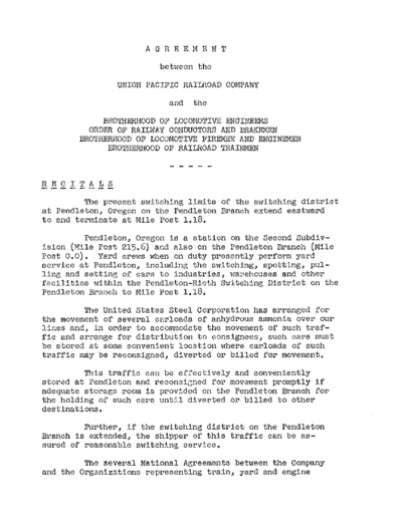SWITCHING LIMITS- PENDLETON
| Description: AGREEMENT between the UNION PACIFIC RAILROAD COMPANY and the BROTHERHOOD OF LOCOMOTIVE ENGINEERS RECITALS The present switching limits of the switching district at Pendleton, Oregon on the Pendleton Branch extend eastward to and terminate at Mile Post 1.18. Pendleton, Oregon is a station on the Second Subdivision (Mile Post 215.6) and also on the Pendleton Branch (Mile Post 0.0). Yard crews when on duty presently perform yard service at Pendleton, including the switching, spotting, pulling and setting of cars to industries, warehouses and other facilities within the Pendleton-Rieth Switching District on the Pendleton Branch to Mile Post 1.18. The United States Steel Corporation has arranged for the movement of several carloads of anhydrous ammonia over our lines and, in order to accommodate the movement of such traffic and arrange for distribution to consignees, such cars must be stored at some convenient location where carloads of such traffic may be reconsigned, diverted or billed for movement. This traffic can be effectively and conveniently stored at Pendleton and reconsigned for movement promptly if adequate storage room is provided on the Pendleton Branch for the holding of such cars until diverted or billed to other destinations. Further, if the switching district on the Pendleton Branch is extended, the shipper of this traffic can be assured of reasonable switching service. The several National Agreements between the Company and the Organizations representing train, yard and engine service employes provide procedures for the extension, i,e., changing of switching limits. These provisions for changing switching limits may be identified from the following National Agreements: (a) BRT: Paragraph (b) of Article 10 (Switching Limits), National Agreement of May 25, 1951. (b) ORC&B: Paragraph (b) of Article 10 (Switching Limits). National Agreement of May 23, 1952. (c) BLF&E: Paragraph (a) of (Changing Switching Limits), Agreement of May 23, 1952, (d) BLE: Paragraph (a) of Article 7 (Changing Switching Limits), National Agreement of May 23, 1952. To provide for storage room and to insure adequate switching and yard service in the movement of carloads of anhydrous ammonia, IT IS AGREED: Section 1. Effective May 15, 1965, the present switching district at Pendleton, Oregon shall be extended eastward a distance of one mile, from Mile Post 1.18 to Mile Post 2.18 on the Pendleton Branch. Section 2. On and after May 15, 1965 yard crews stationed at Pendleton, Oregon will perform all work within the enlarged and extended switching district, including all work on the Pendleton Branch from Mile Post 0.0 to Mile Post 2.18, and such work will be performed under yard service rules, rates and conditions. Section 3. Road crews, on and after the effective date of this Agreement, will perform no yard service within the extended switching district defined in Section 1, hereof, except as to such service as may be permissible within the framework of the respective road train service agreements. Section 4. Should a new industry locate or desire to locate outside of the extended switching district as defined in Section 1 hereof eastward from or beyond Mile Post 2.18 on the Pendleton Branch, such industry may be assured of switching service at Pendleton, Oregon provided the industry is located at a point not to exceed 3 miles eastward from Mile Post 2.18, the eastward limits of the switching district on the Pendleton Branch established pursuant to this agreement. No further changes (extensions) of the Pendleton Switching District eastward from or beyond Mile post 2.18 will be made, except such changes and/or extensions as may be agreed to through negotiations between all the parties signatory to this Agreement. Section 5. This Agreement shall be effective May 15, 1965 and shall continue in effect until changed, altered or amended in accordance with the provisions of the Railway Labor Act, as amended, or as provided in Section 4 of this Agreement. Dated at Portland, Oregon this Twentieth Day of April, 1965. BROTHERHOOD OF LOCOMOTIVE ENGINEERS
|
